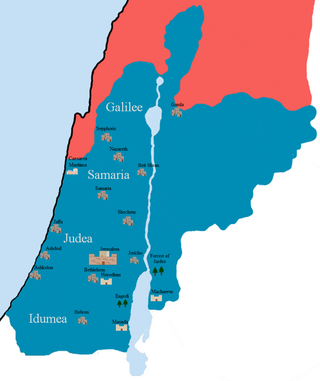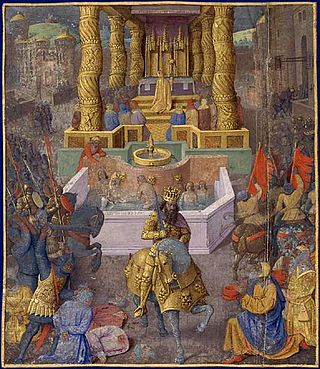
Marcus Antonius, commonly known in English as Mark Antony, was a Roman politician and general who played a critical role in the transformation of the Roman Republic from a constitutional republic into the autocratic Roman Empire.
Year 40 BC was either a common year starting on Thursday, Friday or Saturday or a leap year starting on Thursday or Friday of the Julian calendar and a common year starting on Friday of the Proleptic Julian calendar. At the time, it was known as the Year of the Consulship of Calvinus and Pollio. The denomination 40 BC for this year has been used since the early medieval period, when the Anno Domini calendar era became the prevalent method in Europe for naming years.

Herod I or Herod the Great was a Roman Jewish client king of the Herodian Kingdom of Judea. He is known for his colossal building projects throughout Judea. Among these works are the rebuilding of the Second Temple in Jerusalem and the expansion of its base—the Western Wall being part of it. Vital details of his life are recorded in the works of the 1st century CE Roman–Jewish historian Josephus.

Herod Agrippa, also known as Herod II or Agrippa I, was the last Jewish king of Judea. He was a grandson of Herod the Great and the father of Herod Agrippa II, the last known king from the Herodian dynasty. He was acquaintance or friend of Roman emperors and even played crucial roles in internal Roman politics.

The Hasmonean dynasty was a ruling dynasty of Judea and surrounding regions during classical antiquity, from c. 140 BCE to 37 BCE. Between c. 140 and c. 116 BCE the dynasty ruled Judea semi-autonomously in the Seleucid Empire, and from roughly 110 BCE, with the empire disintegrating, Judea gained further autonomy and expanded into the neighboring regions of Perea, Samaria, Idumea, Galilee, and Iturea. The Hasmonean rulers took the Greek title basileus ("king") as the kingdom became a regional power for several decades. Forces of the Roman Republic intervened in the Hasmonean Civil War in 63 BCE and made it into a client state, marking the decline of Hasmonean dynasty; Herod the Great displaced the last reigning Hasmonean client-ruler in 37 BCE.

Herodias was a princess of the Herodian dynasty of Judaea during the time of the Roman Empire. Christian writings connect her with John the Baptist's execution.

The First Jewish–Roman War, sometimes called the Great Jewish Revolt, or The Jewish War, was the first of three major rebellions by the Jews against the Roman Empire fought in Roman-controlled Judea, resulting in the destruction of Jewish towns, the displacement of its people and the appropriation of land for Roman military use, as well as the destruction of the Jewish Temple and polity.

Orodes II, was King of Kings of the Parthian Empire from 57 BC to 37 BC. He was a son of Phraates III, whom he murdered in 57 BC, assisted by his elder brother Mithridates IV. The two brothers quickly fell out and entered into a dynastic struggle, in which Orodes was triumphant.

Pacorus I was a Parthian prince, who was the son and heir of Orodes II. The numismatist David Sellwood deduced that Pacorus ruled in c. 39 BC. It is uncertain whether Pacorus ruled alongside his father, or ruled independently. His wife was an unnamed Armenian princess, who was a sister of the Artaxiad king of Armenia, Artavasdes II.

Judaea was a Roman province from 6 to 132 CE, which incorporated the Levantine regions of Judea, Samaria and Idumea, extending over parts of the former regions of the Hasmonean and Herodian kingdoms of Judea. The name Judaea was derived from the Iron Age Kingdom of Judah.

John Hyrcanus II, a member of the Hasmonean dynasty, was for a long time the Jewish High Priest in the 1st century BCE. He was also briefly King of Judea 67–66 BCE and then the ethnarch (ruler) of Judea, probably over the period 47–40 BCE.

Quintus Labienus Parthicus was a Roman general in the Late Republic period. The son of Titus Labienus, he made an alliance with Parthia and invaded the Roman provinces in the eastern Mediterranean which were under the control of Mark Antony. He occupied the Roman province of Syria together with the Parthians in 40 BC. He then pushed into southern Anatolia, still with Parthian support. The main Parthian force took charge of Syria and invaded Judea. Both Labienus and the Parthians were defeated by Publius Ventidius Bassus, who recovered these provinces for Mark Antony.

The Herodian tetrarchy was a regional division of a client state of Rome, formed following the death of Herod the Great in 4 BCE. The latter's client kingdom was divided between his sister Salome I and his sons Herod Archelaus, Herod Antipas, and Philip. Upon the deposition of Herod Archelaus in 6 CE, his territories were transformed into a Roman province. With the death of Salome I in 10 CE, her domain was also incorporated into a province.
The Roman–Parthian Wars were a series of conflicts between the Parthian Empire and the Roman Republic and Roman Empire. It was the first series of conflicts in what would be 682 years of Roman–Persian Wars.

The siege of Jerusalem occurred during Pompey the Great's campaigns in the East, shortly after his successful conclusion of the Third Mithridatic War. Pompey had been asked to intervene in a dispute over inheritance to the throne of the Hasmonean Kingdom, which turned into a war between Hyrcanus II and Aristobulus II. His conquest of Jerusalem, however, spelled the end of Jewish independence and the incorporation of Judea as a client kingdom of the Roman Republic.

The Herodian kingdom was a client state of the Roman Republic ruled from 37 to 4 BCE by Herod the Great, who was appointed "King of the Jews" by the Roman Senate. When Herod died, the kingdom was divided among his sons into the Herodian Tetrarchy.

Herod the Great's siege of Jerusalem was the final step in his campaign to secure the throne of Judea. Aided by Roman forces provided by Marcus Antonius, Herod was able to capture the city and depose Antigonus II Mattathias, ending Hasmonean rule. The siege appears in the writings of Josephus and Dio Cassius.
The Pompeian–Parthian invasion of 40 BC occurred after the Pompeians, backed by the Parthian Empire, had been defeated during the Liberators' civil war by Mark Antony and Octavian.

This article lists historical events that occurred between 1–100 in modern-day Lebanon or regarding its people.















